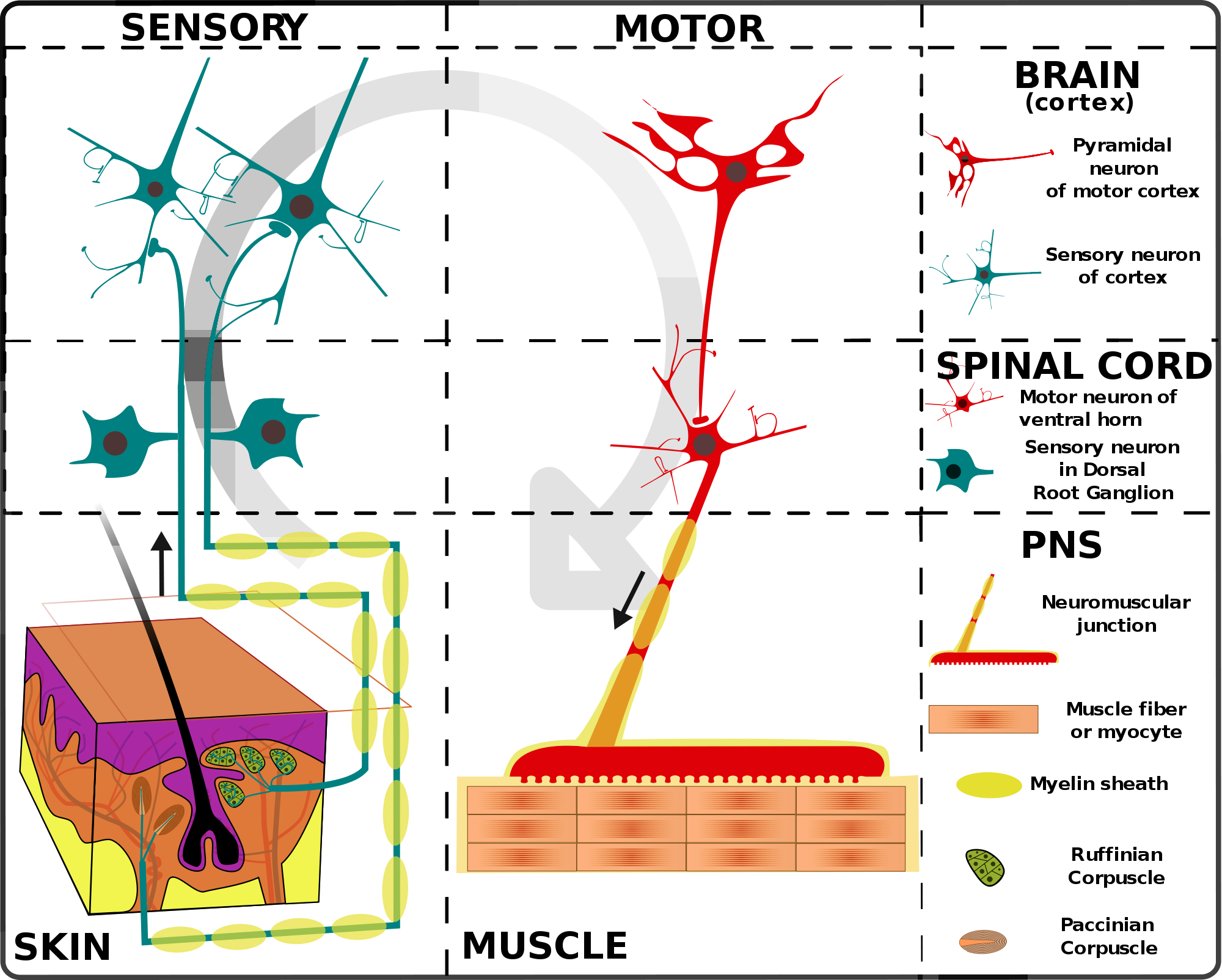Nervous System is the very Important part of Body that coordinates the Voluntary and Involuntary functions .
तंत्रिका तंत्र शरीर का बहुत महत्वपूर्ण हिस्सा है जो स्वैच्छिक और अनौपचारिक कार्यों का समन्वय करता है।
In Vertebrates it consists of Central Nervous System , Peripheral Nervous System & Autonomic Nervous System.
The Central Nervous System consists of Brain ( its weight 1200-1400 gm. consists of 98% of CNS ).
and contains Spinal cord.
केन्द्रीय तंत्रिका तंत्र में मस्तिष्क होते हैं (इसका वजन 1200-1400 ग्राम होता है जिसमें सीएनएस का 98% होता है)।
और रीढ़ की हड्डी होता है
Peripheral Nervous System contains Cranial Nerves & Spinal Nerves .( The PNS Mainly consists of Nerves that are enclosed bundles of the long fibers called Axons, which connects CNS to every parts of Body.) पेरिफेरल नर्वस सिस्टम में क्रैनल नर्व और स्पाइनल नर्व्स शामिल हैं। (पीएनएस मुख्य रूप से नसों के होते हैं जो एक्सोन नामक लंबे तंतुओं के बंडल होते हैं, जो सीएनएस को शरीर के हर हिस्से से जोड़ता है।
A neuron is a microscopic structure composed of three major parts, namely, cell body, dendrites and axon.
एक न्यूरॉन एक सूक्ष्म संरचना है जो तीन प्रमुख हिस्सों से बना है, अर्थात् सेल बॉडी, डेन्ड्राइट्स और अक्षतंतु।
Autonomic Nervous System are divided into Sympathetic & Parasympathetic Nervous system.
Neurotransmitters ( तंत्रिका संवाहक )are Chemicals which are released at Synapses(अन्तर्ग्रथन ).
Nervous System consists of two types of cells .
Neurons & Glial cells.
तंत्रिका तंत्र में दो प्रकार के कोशिकाएं होती हैं। न्यूरॉन्स और ग्लेल कोशिकाएं
Neurons are the basic units of Nervous system.
न्यूरॉन्स तंत्रिका तंत्र की मूल इकाइयां हैं।
Glial cell are basically non neuronal cell, it supports signal transmission of Nervous system.
ग्लिअल सेल मूल रूप से न्यूरोनल सेल नहीं हैं, यह तंत्रिका तंत्र के संकेत संचरण का समर्थन करता है।
Meninges covers the Brain and Spinal cord.
Acetylcholine is a Neurotransmitters releases at synapses induced rapid contraction of muscle cell.
Brain is divided into Fore brain , Mid brain , Hind brain.
Fore brain -
Consist of Cerebrum , Thalamus , Hypothalamus .
Cerebrum : It is the largest part of human brain. also called Part of Intelligence.
Co-ordinates all voluntary actions of the body.
Thalamus : It works to correlate several important functions or processes including consciousness, sleep and sensory interpretation.संवेदी व्याख्या
Hypothalamus : It controls the secretion of Endocrine Gland and link to the Nervous System via Pituitary gland.
Hypothalamus controls Emotions .
It Controls body temperature. Normal - 37°C (98.6°F)
Hypothalamus also controls the Hunger & Thirst ,Sexual attraction and Love.
Mid brain-
It is a part of Hearing ,Vision, Pain relief & Movement.
Controles Eye Movements.

Hind brain-
Cerebellum : It coordinates the Voluntary movement . such as Posture, coordination, Balance and Speech etc.
The cerebellum is a region of the brain that plays an important role in motor control. It may also be involved in some cognitive functions such as attention and language, and in regulating fear and pleasure responses, but its movement-related functions are the most solidly established.
Cerebellum मस्तिष्क का एक क्षेत्र है जो मोटर नियंत्रण में एक महत्वपूर्ण भूमिका निभाता है। यह ध्यान और भाषा जैसे कुछ संज्ञानात्मक कार्यों में भी शामिल हो सकता है, और भय और खुशी प्रतिक्रियाओं को विनियमित करने में, लेकिन इसके संचालन से संबंधित कार्यों को सबसे दृढ़ता से स्थापित किया जाता है।

Medulla oblongata- It has cardiovascular and breathing center.
It also controls activities such as Sneezing, Coughing, Swallowing, Salivation, Vomiting,
It also called the center of Respiration and Circulation .
Sensory and Motor neuron from fore brain and mid brain travel through the medulla .
:max_bytes(150000):strip_icc():format(webp)/model-brain-121277212-5a91ee79875db90036fbe39c.jpg)
electroencephalogram (EEG) -It records electrical patterns in your brain. ( इसके द्वारा मस्तिष्क की क्रिया सीलता विद्युत विभवो के रूप में अभिलिखित होती है।



No comments:
Post a Comment